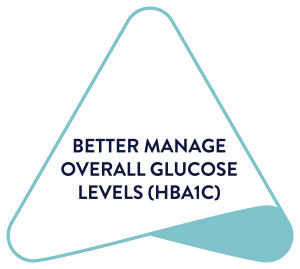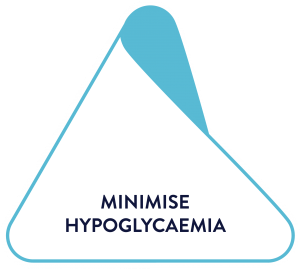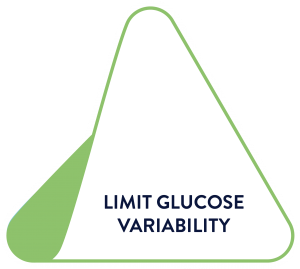The Triangle of Diabetes Care is an emerging treatment strategy that is centred around three diabetes management targets, reaching all three can help improve outcomes for patients with Type 1 and Type 2 diabetes. When used with the FreeStyle Libre systems,* you can help your patients hit targets in all three areas using the glucose data from their sensor to inform your treatment plan.
Triangle of Diabetes Care
The 3 key areas for improving diabetes management
What is the Triangle of Diabetes Care?

Improve overall glucose levels

Minimise hypoglycaemia

The FreeStyle Libre systems* are proven to help users reduce hypoglycaemia
The FreeStyle Libre systems* all display trend arrows to show your patients where their glucose levels are heading. This means that even in the absence of hypoglycaemic symptoms, your patient can know if their glucose levels are falling and take the appropriate action. Current Time in Range consensus suggests less than <3.9mmol/L & less than 4% including 1% <3mmol/L of time should be spent below those ranges for adults with type 1 and type 2 diabetes who are not pregnant, not older, or at risk.3
FreeStyle Libre systems* are proven to reduce time spent in hypoglycaemia (<3.9mmol/L) significantly. The same independent study published in the New England Journal of Medicine found that FreeStyle Libre 2 users spent 43 minutes less time in hypoglycaemia per day at 6 months of use vs SMBG.1,**
Find out more about minimising hypoglycaemia in our Healthcare Professional Education modules about the the Triangle of Diabetes Care and Targeting Hypoglycaemia.
Limit glucose variability

FreeStyle Libre Portfolio & The Triangle of Diabetes Care
The FreeStyle Libre portfolio empowers patients to hit targets on each of the three sides of the Triangle of Diabetes Care and improve their overall glucose control. Even if one goal cannot be reached, an improvement of one or both of the other goals will have a positive effect on the overall health of your patients.
Additional Resources
Webinars
We offer various on-demand webinars for Healthcare Professionals including a spotlight on hypoglycaemia.
Educational Modules
Learn more about the Triangle of Diabetes Care and the FreeStyle Libre portfolio through our Healthcare Professional education modules.
Real-World Data
Find out more about living with diabetes and how the FreeStyle Libre portfolio can help patients better manage their diabetes using data from real users.
References & Disclaimers
SMBG=self-monitored blood glucose
* FreeStyle Libre systems refers to the FreeStyle Libre 2 and FreeStyle Libre 3 systems
** The data from this study was collected using the FreeStyle Libre 2 system. FreeStyle Libre 3 system has the same features as the FreeStyle Libre 2 system therefore, the study data is applicable to both products.
^ Adjusted Mean Between-Group Difference (95% CI)
1. Leelarathna, L. N Engl J Med. (2022): DOI: 10.1056/NEJMoa2205650.
2. UK Hypoglycaemia Study Group. Risk of hypoglycaemia in types 1 and 2 diabetes: effects of treatment modalities and their duration. Diabetologia 50, 1140–1147 (2007). https://doi.org/10.1007/s00125-007-0599-y
3. Battelino, T. Diabetes Care (2019): https://doi.org/10.2337/dci19-0028
4. Ceriello A. et al, Lancet Diabetes Endocrinol 2019 : http://dx.doi.org/10.1016/S2213-8587(18)30136-0
5. Kilpatrick, E.S., Rigby, A.S. & Atkin, S.L. Mean blood glucose compared with HbA1c in the prediction of cardiovascular disease in patients with type 1 diabetes. Diabetologia 51, 365–371 (2008). https://doi.org/10.1007/s00125-007-0883-x
ADC-57865 V4.0
.svg)

